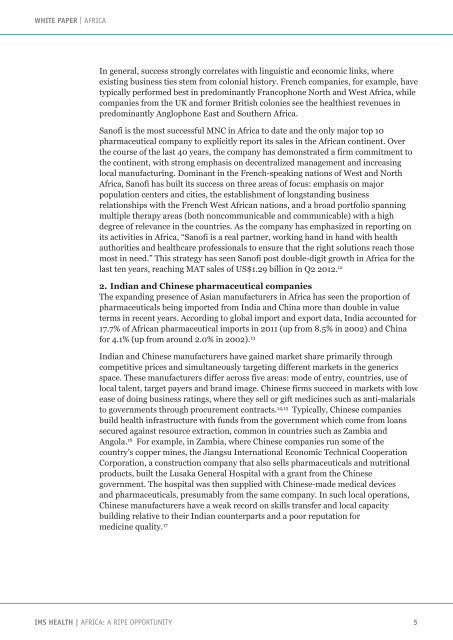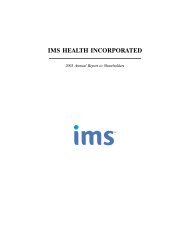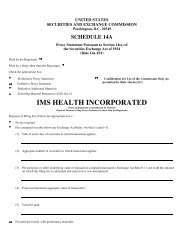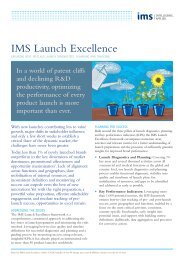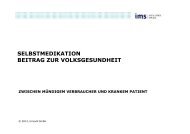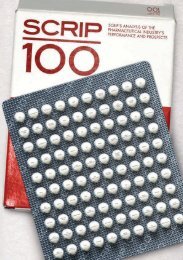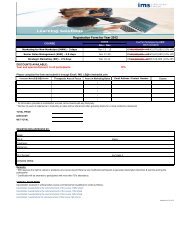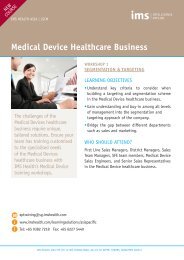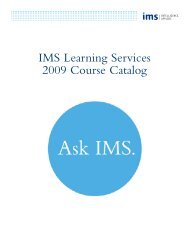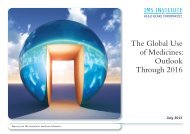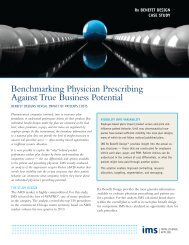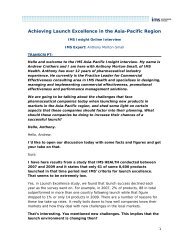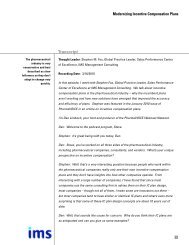Africa: A ripe opportunity - IMS Health
Africa: A ripe opportunity - IMS Health
Africa: A ripe opportunity - IMS Health
Create successful ePaper yourself
Turn your PDF publications into a flip-book with our unique Google optimized e-Paper software.
WHITE PAPER | AFRICA<br />
In general, success strongly correlates with linguistic and economic links, where<br />
existing business ties stem from colonial history. French companies, for example, have<br />
typically performed best in predominantly Francophone North and West <strong>Africa</strong>, while<br />
companies from the UK and former British colonies see the healthiest revenues in<br />
predominantly Anglophone East and Southern <strong>Africa</strong>.<br />
Sanofi is the most successful MNC in <strong>Africa</strong> to date and the only major top 10<br />
pharmaceutical company to explicitly report its sales in the <strong>Africa</strong>n continent. Over<br />
the course of the last 40 years, the company has demonstrated a firm commitment to<br />
the continent, with strong emphasis on decentralized management and increasing<br />
local manufacturing. Dominant in the French-speaking nations of West and North<br />
<strong>Africa</strong>, Sanofi has built its success on three areas of focus: emphasis on major<br />
population centers and cities, the establishment of longstanding business<br />
relationships with the French West <strong>Africa</strong>n nations, and a broad portfolio spanning<br />
multiple therapy areas (both noncommunicable and communicable) with a high<br />
degree of relevance in the countries. As the company has emphasized in reporting on<br />
its activities in <strong>Africa</strong>, “Sanofi is a real partner, working hand in hand with health<br />
authorities and healthcare professionals to ensure that the right solutions reach those<br />
most in need.” This strategy has seen Sanofi post double-digit growth in <strong>Africa</strong> for the<br />
last ten years, reaching MAT sales of US$1.29 billion in Q2 2012. 12<br />
2. Indian and Chinese pharmaceutical companies<br />
The expanding presence of Asian manufacturers in <strong>Africa</strong> has seen the proportion of<br />
pharmaceuticals being imported from India and China more than double in value<br />
terms in recent years. According to global import and export data, India accounted for<br />
17.7% of <strong>Africa</strong>n pharmaceutical imports in 2011 (up from 8.5% in 2002) and China<br />
for 4.1% (up from around 2.0% in 2002). 13<br />
Indian and Chinese manufacturers have gained market share primarily through<br />
competitive prices and simultaneously targeting different markets in the generics<br />
space. These manufacturers differ across five areas: mode of entry, countries, use of<br />
local talent, target payers and brand image. Chinese firms succeed in markets with low<br />
ease of doing business ratings, where they sell or gift medicines such as anti-malarials<br />
to governments through procurement contracts. 14,15 Typically, Chinese companies<br />
build health infrastructure with funds from the government which come from loans<br />
secured against resource extraction, common in countries such as Zambia and<br />
Angola. 16 For example, in Zambia, where Chinese companies run some of the<br />
country’s copper mines, the Jiangsu International Economic Technical Cooperation<br />
Corporation, a construction company that also sells pharmaceuticals and nutritional<br />
products, built the Lusaka General Hospital with a grant from the Chinese<br />
government. The hospital was then supplied with Chinese-made medical devices<br />
and pharmaceuticals, presumably from the same company. In such local operations,<br />
Chinese manufacturers have a weak record on skills transfer and local capacity<br />
building relative to their Indian counterparts and a poor reputation for<br />
medicine quality. 17<br />
<strong>IMS</strong> HEALTH | AFRICA: A RIPE OPPORTUNITY 5


